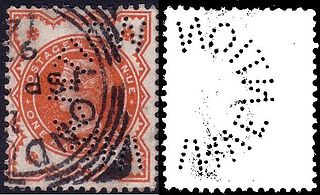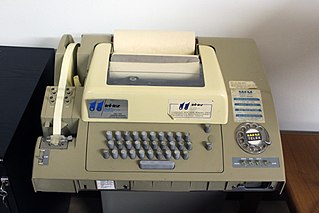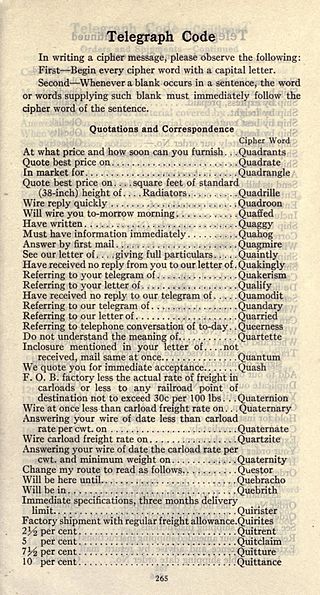An abbreviation is a shortened form of a word or phrase, by any method. It may consist of a group of letters or words taken from the full version of the word or phrase; for example, the word abbreviation itself can be abbreviated as abbr., abbrv., or abbrev.. It may also consist of initials only, a mixture of initials and words, or words or letters representing words in another language. Some types of abbreviations are acronyms or grammatical contractions or crasis.
In communications and information processing, code is a system of rules to convert information—such as a letter, word, sound, image, or gesture—into another form, sometimes shortened or secret, for communication through a communication channel or storage in a storage medium. An early example is an invention of language, which enabled a person, through speech, to communicate what they thought, saw, heard, or felt to others. But speech limits the range of communication to the distance a voice can carry and limits the audience to those present when the speech is uttered. The invention of writing, which converted spoken language into visual symbols, extended the range of communication across space and time.

Electrical telegraphs were point-to-point text messaging systems, primarily used from the 1840s until the late 20th century. It was the first electrical telecommunications system and the most widely used of a number of early messaging systems called telegraphs, that were devised to communicate text messages quicker than physical transportation. Electrical telegraphy can be considered to be the first example of electrical engineering.

Morse code is a method used in telecommunication to encode text characters as standardized sequences of two different signal durations, called dots and dashes, or dits and dahs. Morse code is named after Samuel Morse, one of the early developers of the system adopted for electrical telegraphy.

Short Message/Messaging Service, commonly abbreviated as SMS, is a text messaging service component of most telephone, Internet and mobile device systems. It uses standardized communication protocols that let mobile devices exchange short text messages. An intermediary service can facilitate a text-to-voice conversion to be sent to landlines.

Telegraphy is the long-distance transmission of messages where the sender uses symbolic codes, known to the recipient, rather than a physical exchange of an object bearing the message. Thus flag semaphore is a method of telegraphy, whereas pigeon post is not. Ancient signalling systems, although sometimes quite extensive and sophisticated as in China, were generally not capable of transmitting arbitrary text messages. Possible messages were fixed and predetermined and such systems are thus not true telegraphs.

Wireless telegraphy or radiotelegraphy is transmission of text messages by radio waves, analogous to electrical telegraphy using cables. Before about 1910, the term wireless telegraphy was also used for other experimental technologies for transmitting telegraph signals without wires. In radiotelegraphy, information is transmitted by pulses of radio waves of two different lengths called "dots" and "dashes", which spell out text messages, usually in Morse code. In a manual system, the sending operator taps on a switch called a telegraph key which turns the transmitter on and off, producing the pulses of radio waves. At the receiver the pulses are audible in the receiver's speaker as beeps, which are translated back to text by an operator who knows Morse code.

The Zimmermann Telegram was a secret diplomatic communication issued from the German Foreign Office in January 1917 that proposed a military alliance between the German Empire and Mexico if the United States entered World War I against Germany. With Germany's aid, Mexico would recover Texas, Arizona, and New Mexico. The telegram was intercepted by British intelligence.

Text messaging, or texting, is the act of composing and sending electronic messages, typically consisting of alphabetic and numeric characters, between two or more users of mobile devices, desktops/laptops, or another type of compatible computer. Text messages may be sent over a cellular network or may also be sent via satellite or Internet connection.
A telegraph code is one of the character encodings used to transmit information by telegraphy. Morse code is the best-known such code. Telegraphy usually refers to the electrical telegraph, but telegraph systems using the optical telegraph were in use before that. A code consists of a number of code points, each corresponding to a letter of the alphabet, a numeral, or some other character. In codes intended for machines rather than humans, code points for control characters, such as carriage return, are required to control the operation of the mechanism. Each code point is made up of a number of elements arranged in a unique way for that character. There are usually two types of element, but more element types were employed in some codes not intended for machines. For instance, American Morse code had about five elements, rather than the two of International Morse Code.

A telegraphic address or cable address was a unique identifier code for a recipient of telegraph messages. Operators of telegraph services regulated the use of telegraphic addresses to prevent duplication. Rather like a uniform resource locator (URL), the telegraphic address did not contain any routing information, but instead could be looked up by telegraph office personnel, who would then manually direct the message to the office nearest the destination or to an intermediate office. Since the destination address of a telegram counted as part of the message, using a short registered address code saved the expense of sending a complete street address. Telegraphic addresses were chosen either as versions of a company's name or as a memorable short word somehow associated with the recipient. Occasionally, an organization would come to be best known by its telegraphic address, for example Interflora, Interpol and Oxfam. A telegraphic address was a valuable part of a company's corporate identity, and disputes sometimes arose when a competitor registered a telegraphic address similar to a trade name or identifier used by a rival.

Procedural signs or prosigns are shorthand signals used in Morse code telegraphy, for the purpose of simplifying and standardizing procedural protocols for land-line and radio communication. The procedural signs are distinct from conventional Morse code abbreviations, which consist mainly of brevity codes that convey messages to other parties with greater speed and accuracy. However, some codes are used both as prosigns and as single letters or punctuation marks, and for those, the distinction between a prosign and abbreviation is ambiguous, even in context.

Morse code abbreviations are used to speed up Morse communications by foreshortening textual words and phrases. Morse abbreviations are short forms, representing normal textual words and phrases formed from some (fewer) characters taken from the word or phrase being abbreviated. Many are typical English abbreviations, or short acronyms for often-used phrases.

Australia was a relatively early adopter of electrical telegraph technology in the middle of the nineteenth century, despite its low population densities and the difficult conditions sometimes encountered in laying lines. From 1858 onwards, the major capitals were progressively linked, culminating in the addition of Perth in 1877. Australia was linked to the rest of the world for the first time in 1872, through the Overland Telegraph which ran some 3,200 kilometres (2,000 mi) from Adelaide through to Darwin. The network continued to expand in size and sophistication until 1959 and in heavy usage until 1945, after which time telephone usage began to erode public patronage of telegraphy services. The final publicly provided telegraphy service was closed in 1993.

Short Message Service (SMS) language, textism, or textese is the abbreviated language and slang commonly used in the late 1990s and early 2000s with mobile phone text messaging, and occasionally through Internet-based communication such as email and instant messaging.
A wire signal is a brevity code used by telegraphers to save time and cost when sending long messages. The best-known code was the 92 Code adopted by Western Union in 1859. The code was designed to reduce bandwidth consumption over telegraph lines, thus speeding transmissions by utilizing a numerical code system for frequently used phrases.

Telex is a telecommunication service that provides text-based message exchange over the circuits of the public switched telephone network or by private lines. The technology operates on switched station-to-station basis with teleprinter devices at the receiving and sending locations. Telex was a major method of sending written messages electronically between businesses in the post–World War II period. Its usage went into decline as the fax machine grew in popularity in the 1980s.

In telecommunication, a commercial code is a code once used to save on cablegram costs. Telegraph charged per word sent, so companies which sent large volumes of telegrams developed codes to save money on tolls. Elaborate commercial codes which encoded complete phrases into single words were developed and published as codebooks of thousands of phrases and sentences with corresponding codewords. Commercial codes were not generally intended to keep telegrams private, as codes were widely published; they were usually cost-saving measures only.
Australian railway telegraphic codes were devised to reduce the size of telegraphic messages, though some survived into the telephone era. They were used in telegrams between various parts of the railway system, such as offices, stations, locomotive depots and goods yards.

In the nineteenth century, the United Kingdom of Great Britain and Ireland had the world's first commercial telegraph company. British telegraphy dominated international telecommunications well into the twentieth. Telegraphy is the sending of textual messages by human operators using symbolic codes. Electrical telegraphy used conducting wires to send messages, often incorporating a telegram service to deliver the telegraphed communication from the telegraph office. This is distinct from optical telegraphy that preceded it and the radiotelegraphy that followed. Though Francis Ronalds first demonstrated a working telegraph over a substantial distance in 1816, he was unable to put it into practical use. Starting in 1836, William Fothergill Cooke, with the scientific assistance of Charles Wheatstone, developed the Cooke and Wheatstone telegraph. The needle telegraph instrument suggested by Wheatstone, the battery invented by John Frederic Daniell, and the relay invented by Edward Davy were important components of this system.
















